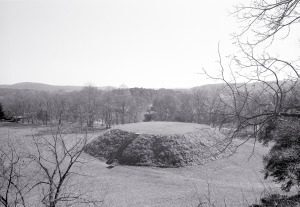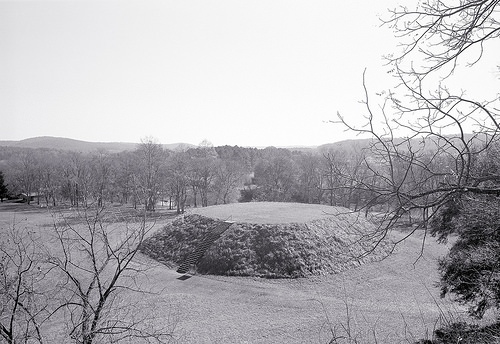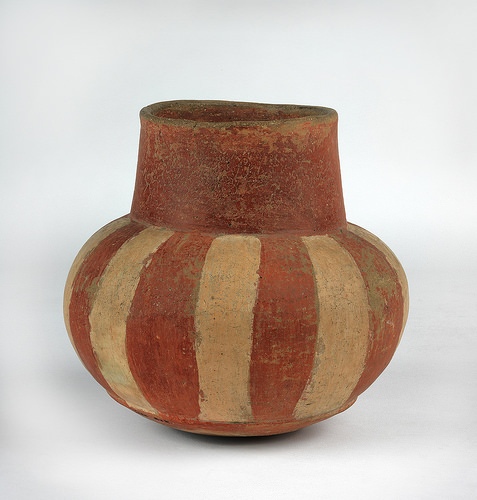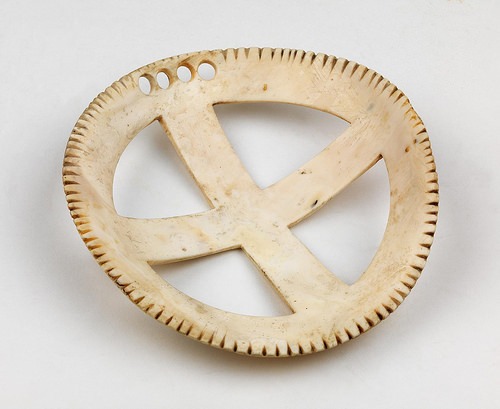
PHILADELPHIA, PA 2017—The Great Pyramids in Egypt, Stonehenge in England, and the Maya city of Teotihuacan were all built thousands of years ago. Add to that list of extraordinary achievements the earthen mounds—some rising to heights of 70 or 100 feet, some more than 5,000 years old—that dot the landscape of North America.
Moundbuilders: Ancient Architects of North America, a new exhibition opening June 24 at the Penn Museum in Philadelphia, tells the sometimes enigmatic story of more than 5,000 years of Native American moundbuilding through photographs, archival excavation records, and more than 60 artifacts excavated at mound sites throughout the eastern United States. The exhibition runs through December 2017.
About the Mounds
Earthen mounds—including some of the earliest monumental constructions in the world— have been engineered by diverse Native American groups over millennia. Yet the sizes, shapes, and purposes of mounds have varied greatly over time and geographical distance. Mounds have played and continue to play important roles in the religious, social, and political lives of Native American people. Some have been burial mounds; others have been centers of trade and community gatherings; still others have served as the foundations for important buildings or activities.
Archaeologists, fascinated by the extraordinary engineering feats of the moundbuilders, have been excavating and mapping this tradition since the 18th century. To date, many thousands of mounds have been discovered, from those at Cahokia, the massive Native American city outside Saint Louis, Missouri, to smaller mound sites like Smith Creek in Mississippi where the Penn Museum currently excavates. Over time, many mounds have been destroyed by farmers or leveled due to urban expansion; many more are believed to exist, not yet discovered.
A Chronological Approach
Moundbuilders explores the changing patterns of the construction and use of Native American mounds through time, beginning with the earliest known mounds, built by small groups of hunter-gatherers in the Lower Mississippi Valley as early as 3700 BCE. Without the help of metal tools, these early mound builders worked by hand moving basket loads of dirt. By 1400 BCE, the Poverty Point site in Louisiana was home to mounds that required thousands of laborers. In addition, exquisitely carved stone artifacts uncovered at the site suggest specialized artisans and an extensive trade network for materials.
Moundbuilding became much more common in later years. These constructions began to serve as burial places and certain burials were accompanied by elaborate grave goods. Some sites, like those associated with the Hopewell culture in Ohio (1 to 400 CE), included huge geometric enclosures that served as ceremonial centers for the surrounding populations. Around 600 CE, dramatic shifts in moundbuilding practices occured. In the Upper Mississippi Valley, people built thousands of effigy mounds in the shapes of animals. Further south, flat-topped platform mounds were built, serving as foundations for structures or stages for public activities.
Platform mounds were the most common mound form in the centuries leading up to European contact when corn agriculture developed and people congregated in major cities ruled by powerful chiefs. Though moundbuilding had largely ceased, some of these sites were still occupied when Europeans visited them in the 16th and 17thcenturies. A small renaissance of moundbuilding has begun today, as the Eastern Band of Cherokee Indians continues to construct the Kituwah mound in the mountains of North Carolina.
_______________________________________
Mound B from atop Mound A (Great Temple Mound), Etowah Mounds, Near Cartersville,Georgiaca. 1250 CE. This black and white photograph by Tom Patton shows one of many large Mississippian period mound centers that dotted the landscape of eastern North America before European contact. Image courtesy Penn Museum
______________________________________________________
Artifacts from the Mounds
The exhibition includes excavated artifacts made from a variety of materials, including stone, such as the intricately carved underwater panther boatstone believed to be used as a weight on a spear thrower; ceramic, such as pots formed in the shape of human effigy figures; and shell, such as pendants from Key Marco, Florida. These latter objects bear sacred designs associated with the Southeastern Ceremonial Complex—a system of signs and symbols shared among different groups living hundreds of miles apart ca. 1000 – 1500 CE. In addition, visitors have an insider’s view into modern-day mound excavation through video footage of Dr. Kassabaum and her students excavating at Smith Creek in 2015. A case displaying hundreds of artifacts recovered on that expedition gives the visitor a sense of what most archaeological material looks like right after it is excavated.
________________________________________
Clay jar. 1200–1500 CE (Mississippian). Arkansas, Montgomery County. This ancient Mississippian Period ceramic jar, 17 cm tall by 18.5 cm wide, is from Arkansas. The style of decoration can help archaeologists determine when and where a pot was made, and the shape and size of the vessel can point to the types of activities taking place at the site. Image courtesy Penn Museum
Photographing the North American mounds, often surrounded by lush greenery, farm fields, or nearby roadways, can be a challenge. For this exhibition, 38 photographs, the black and white work of two contemporary photographers—Jenny Ellerbe and Tom Patton—is featured. Their work captures the serene quality of these ancient sites while also illustrating how they are squeezed into today’s modern landscapes.
About the Curator
Dr. Megan Kassabaum, Weingarten Assistant Curator for North America at the Penn Museum and an archaeologist who directs the Smith Creek Archaeological Project, is curator of the exhibition. She has worked on mound sites throughout the eastern United States since 1999. Since 2005, she has worked in the Lower Mississippi Valley, exploring mounds constructed by the Coles Creek culture (700 to 1200 CE). As part of this fieldwork, she leads tours of many of the mound sites that are publically visible and has helped to develop a driving trail that allows visitors to explore sites that were built over the course of 5000 years along the Mississippi River.
“You don’t need a passport to visit extraordinary ancient monuments,” she noted. “I hope this exhibition will encourage more Americans to visit mound sites and gain a better understanding of the deep history of Native American peoples who’ve lived in North America for many thousands of years.”
Article Source: Penn Museum news release
The Penn Museum (the University of Pennsylvania Museum of Archaeology and Anthropology) is dedicated to the study and understanding of human history and diversity. Founded in 1887, the Museum has sent more than 300 archaeological and anthropological expeditions to all the inhabited continents of the world. With an active exhibition schedule and educational programming for children and adults, the Museum offers the public an opportunity to share in the ongoing discovery of humankind’s collective heritage.
The Penn Museum is located at 3260 South Street, Philadelphia, PA 19104 (on Penn’s campus, across from Franklin Field). Public transportation to the Museum is available via SEPTA’s Regional Rail Line at University City Station; the Market-Frankford Subway Line at 34th Street Station; trolley routes 11, 13, 34, and 36; and bus routes 21, 30, 40, and 42. Museum hours are Tuesday through Sunday, 10:00 am to 5:00 pm, and first Wednesdays of each month until 8:00 pm, with P.M. @ PENN MUSEUM evening programs offered Wednesdays, June 28 through September 6. Closed Mondays and holidays. Admission donation is $15 for adults; $13 for senior citizens (65 and above); free for U.S. Military; $10 for children and full-time students with ID; free to Members, PennCard holders, and children 5 and younger. July and August: special admission donation is $10 for adults, seniors, children (6 to 17) and full time students with ID.
Hot and cold meals and light refreshments are offered to visitors with or without Museum admission in The Pepper Mill Café; the Museum Shop offers a wide selection of gifts, books, games, clothing and jewelry. Penn Museum can be found on the web at www.penn.museum. For general information call 215.898.4000. For group tour information call 215.746.8183.
__________________________________________________
Subscribe to Popular Archaeology Premium. Available on all laptops and mobile devices, and still the industry’s best value at only $9.00 annually.
___________________________________________
Travel and learn with Far Horizons.
____________________________________________
This richly illustrated issue includes the following stories: Recent findings shedding new light on the whereabouts of the remains of Philip of Macedon, father of Alexander the Great; how an archaeologist-sculptor is bringing bones of the dead back to life; archaeologists uncovering town life at the dawn of civilization; an exclusive interview with internationally acclaimed archaeologist James M. Adovasio about what makes the Meadowcroft Rockshelter prominent in the ongoing search for the first Americans; what archaeologists are finding at the site of the ancient city of Gath, the home town of the biblical Philistine giant, Goliath; and how scientists are redrawing the picture of human evolution in Europe. Find it on Amazon.com.









